M101 hires STScI-PRC2006-10a
Credit:
Image: European Space Agency & NASA
Acknowledgements:
Project Investigators for the original Hubble data: K.D. Kuntz (GSFC), F. Bresolin (University of Hawaii), J. Trauger (JPL), J. Mould (NOAO), and Y.-H. Chu (University of Illinois, Urbana)
Image processing: Davide De Martin (ESA/Hubble)
CFHT image: Canada-France-Hawaii Telescope/J.-C. Cuillandre/Coelum
NOAO image: George Jacoby, Bruce Bohannan, Mark Hanna/NOAO/AURA/NSFhttp://www.spacetelescope.org/copyright/ : Usage of images, videos and web texts
Summary
ESA/Hubble images, videos and web texts are released under the Creative Commons Attribution 3.0 Unported license and may on a non-exclusive basis be reproduced without fee provided they are clearly and visibly credited. Detailed conditions are below.
Conditions
The full image or footage credit must be presented in a clear and readable manner to all users, with the wording unaltered (for example: "ESA/Hubble"). Web texts should be credited to ESA/Hubble (except when used by media). The credit should not be hidden or disassociated from the image footage. Links should be active if the credit is online. See the usage rights Q&A section on this page for guidance.
...
Usage rights Q&A
...
Q: Do I need to contact all the people named in the credit line for permission to use an image or video?
A: No. Images and videos published on spacetelescope.org are, unless explicitly stated otherwise, cleared for reuse without needing to contact the individuals or organisations listed. Their names must not be removed from the credit, however.
...Relevante Bilder

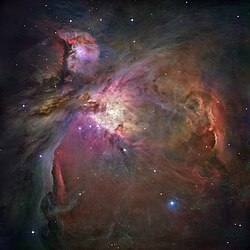
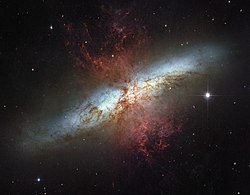
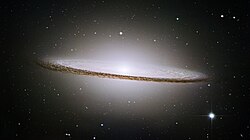









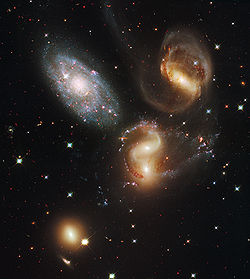

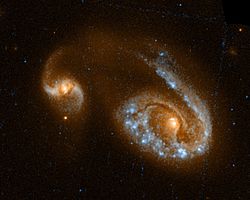

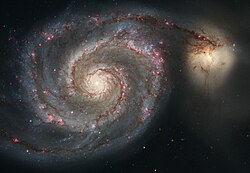








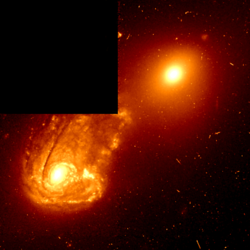




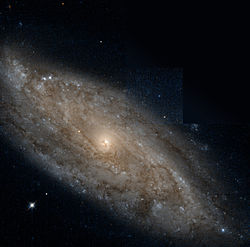






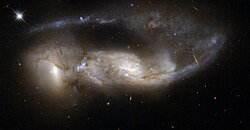



Relevante Artikel
Messier 101Messier 101 oder M101, auch als NGC 5457 bezeichnet und Feuerradgalaxie genannt, ist eine Spiralgalaxie im Sternbild Großer Bär, die mit einer scheinbaren Größe von 28,8′ × 26,9′ und scheinbarer Helligkeit von 7,5 mag erscheint. Ihre Entfernung zur Erde beträgt rund 21 Millionen Lichtjahre, ihr Durchmesser 170.000 Lichtjahre. Damit ist sie ungefähr so groß wie unsere Milchstraße. .. weiterlesen
SpiralgalaxieEine Spiralgalaxie, veraltet auch Spiralnebel, ist eine scheibenförmige Galaxie, deren Erscheinung ein Spiralmuster zeigt. Der Zentralbereich, Bulge genannt, ist sphäroidal und besteht hauptsächlich aus älteren Sternen. Die Scheibe zeigt eine Spiralstruktur mit meist mehreren Spiralarmen. Spiralgalaxien enthalten in der Scheibe verhältnismäßig viel Gas. Dadurch können permanent neue Sterne gebildet werden. Die Spiralarme erscheinen durch die hier neugebildeten Sterne bläulich. Eingebettet ist die Galaxie in einen Halo unsichtbarer Dunkler Materie. Zusammen mit den lentikulären Galaxien werden Spiralgalaxien auch als Scheibengalaxien zusammengefasst. Galaxien, bei denen vom Bulge ausgehend ein Balken sichtbar ist, an dem die Spiralarme ansetzen, nennt man Balkenspiralgalaxien. Die Milchstraße selbst ist eine Balkenspiralgalaxie. In einem Umkreis von etwa 30 Millionen Lichtjahren um die Milchstraße sind rund 34 Prozent der Galaxien Spiralgalaxien, 13 Prozent elliptische Galaxien und 53 Prozent irreguläre Galaxien und Zwerggalaxien. .. weiterlesen
Atlas of Peculiar GalaxiesDer Atlas of Peculiar Galaxies ist ein astronomischer Katalog. In ihm sind 338 ungewöhnliche Galaxien mit photographischen Aufnahmen aufgeführt. .. weiterlesen
GalaxieEine Galaxie ist eine durch Gravitation gebundene große Ansammlung von Sternen, Planetensystemen, Gasnebeln, Staubwolken, Dunkler Materie und sonstigen astronomischen Objekten mit einer Gesamtmasse von typischerweise 109 bis 1013 Sonnenmassen (M☉). Ihr Durchmesser kann mehrere hunderttausend Lichtjahre betragen. Während große Galaxien häufig die Struktur von Spiralen ausbilden, sind Zwerggalaxien zumeist irregulären Typs. Daneben existieren weitere Arten und Formen. Die Milchstraße, Heimatgalaxie unseres Sonnensystems, ist eine Balkenspirale von rund 1,5 Billionen M☉ mit etwa 250 Milliarden Sternen. Von der Erde aus lassen sich mit aktueller Technik mehr als 50 Milliarden Galaxien beobachten. Seit 2016 geht die Forschung davon aus, dass sich im beobachtbaren Universum ca. eine Billion Galaxien befinden. .. weiterlesen
Messier-KatalogDer Messier-Katalog ist eine Auflistung 110 ortsfester astronomischer Objekte, die neblig erscheinen und keine Kometen sind. Er ist der erste einer langen Reihe von Nebelkatalogen. .. weiterlesen
